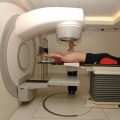Chapter 6 Samantha Turnbull St James’ Institute of Oncology, UK Some breast cancers have high levels of expression of oestrogen and/or progesterone receptors. As the growth of hormone-receptor positive breast tumours can be dependent on oestrogen activity, endocrine treatments for breast cancer generally rely on its suppression, which can be done in a variety of ways. Fulvestrant is a pure oestrogen antagonist, with no agonistic properties like the SERMs. It is given IM and the most frequent adverse events associated with its use are hot flushes, nausea, myalgia and arthralgia, increased risk of VTE and vaginal bleeding. Androgen blockade is one of the mainstays of treatment of prostate cancer. Surgical castration (bilateral orchidectomy) is one mechanism of controlling the growth of tumours of the prostate, but there are also a number of medical therapies used. Chapter 3, sections on bone metastases and osteoporosis, sexual dysfunction There are currently a number of strategies for utilising the immune response in cancer therapy, including monoclonal antibodies and cancer vaccines. In recent years there have been a number of significant developments in this area. Side effects Toxicities are generally immune related, particularly:
Endocrine therapy, immunotherapy and targeted therapies
Endocrine therapy
Breast cancer
Selective oestrogen receptor modulators (SERMs)
Oestrogen receptor antagonists
Aromatase inhibitors
Prostate cancer
Gonadotrophin releasing hormone (GnRH) agonists
Gonadotrophin releasing hormone (GnRH) antagonists
Anti-androgens
Inhibitors of steroidogenesis
Other relevant sections of this book
References
Immunotherapy
Introduction
Ipilumumab and CTLA-4
Stay updated, free articles. Join our Telegram channel

Full access? Get Clinical Tree






